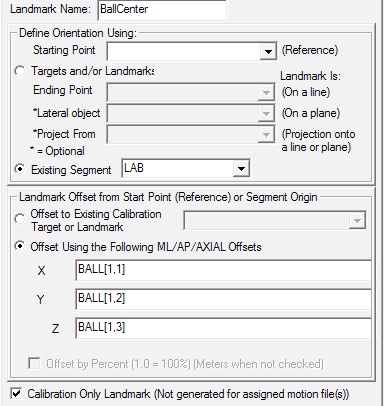Expression Items
Data_Tree
Signals should be placed into the expression in the form:
- SIGNAL_TYPE::SIGNAL_FOLDER::SIGNAL_NAME
To define a specific element of a signal (e.g. the X Component)
- SIGNAL_TYPE::SIGNAL_FOLDER::SIGNAL_NAME::X
To define a specific frame of a data of signal (e.g. Frame 2)
- SIGNAL_TYPE::SIGNAL_FOLDER::SIGNAL_NAME[2]
Data stored in the GLOBAL Workspace should be expressed as follows:
- GLOBAL::SIGNAL_TYPE::SIGNAL_FOLDER::SIGNAL_NAME
NOTE: Global signals can be accessed regardless of the ACTIVE FILES.
Examples for Specifying a Data Tree Signal
- TARGET::ORIGINAL::RFT1 = Signal RFT1 in the TARGET type and ORIGINAL folder
- ANALOG::PROCESSED::FX1 = Signal FX1 in the ANALOG type and PROCESSED folder
- PARAMETER::ANALOG::RATE= Parameter RATE in the ANALOG group of the C3D PARAMETERS
Model_Builder
Model metrics have a simpler syntax. The Signal Type and Signal Folder need not be specified because there is only one version of a signal.
Creating a Landmark at the center of a ball
- Given 6 markers placed on the surface of a round ball
- BALL1, BALL2, BALL3, BALL4, BALL5, BALL6
- Create a model metric at the center of a best fit sphere to the ball.
- Metric Name= BALL
- Metric Expression = Best_Fit_Sphere(List(BALL1, BALL2, BALL3, BALL4, BALL5, BALL6))
- The resulting metric will have 3 values separated by a comma (e.g. the 3 components of the center)
- As an example a center value of (0.5, 0.6, 0.7) would appear as
- 0.5,0.6,0.7
- Create a landmark using this metric data
- Note the syntax for the offsets
- BALL[1,1]
- The syntax may seem a little strange, but [1,1] refers to the first element of the first frame
Pipeline_Parameters
The syntax for using a pipeline parameter as part of an expression is a bit unusual and takes an understanding of how Visual3D parses parameters and pre-processes commands.
The ampersand & is used in pipeline commands to concatenate strings together, and thus is a separator for the parser to find the pieces that need to be parsed separately.
For example, to use a pipeline parameter LP_FREQ:
- /EXPRESSION=2*pi()*&::LP_FREQ
The ampersand tells the parser to take the 2*pi()* and the ::LP_FREQ separately through the pre-parser. The first part is just taken as is since it doesn't have a prefix of ::. The value after the & does have a :: prefix, so it is substituted with the pipeline parameter.
If you have more complex expressions, you might need to surround each pipeline parameter with an ampersand
- &::LP_FREQ&*&::MULTIPLIER&-&::CONSTANT which may evaluate to something like: 60*1.4-90.0 once all the pipeline parameters are substituted.
The general rule is to surround the pipeline parameter with ampersands.
Using a pipeline parameter as part of a signal definition
The syntax is a little funky when it comes to using pipeline parameters in the middle of a signal definition because of the order in which equations are parsed.
The following subtracts two signals.
- Evaluate_Expression
- /EXPRESSION=ANALOG::FILTERED&:&:&::INDEX&:&:&X&-METRIC::PROCESSED&:&:&::INDEX&_zero
- /RESULT_NAME=::INDEX
- /RESULT_TYPE=ANALOG
- /RESULT_FOLDER=OFFSET
- ;
Tags
TAGS can be expressed as follows:
- TAG::TAG_NAME
C3D_Parameters
C3D Parameters can be expressed as follows:
- PARAMETER::GROUP::PARAMETER_NAME
Model_Metrics
Specifying an item from a model
The following Model data is available.
- MODEL::METRIC::NAME
- MODEL::SEGMENT::segname::LENGTH
- MODEL::SEGMENT::segname::DEPTH
- MODEL::SEGMENT::segname::CENTER_OF_MASS
- MODEL::SEGMENT::segname::IXX
- MODEL::SEGMENT::segname::IYY
- MODEL::SEGMENT::segname::IZZ
- MODEL::SEGMENT::segname::MASS
- MODEL::SEGMENT::segname::PROXIMAL_RADIUS
- MODEL::SEGMENT::segname::DISTAL_RADIUS
- MODEL::SEGMENT::segname::ORIGIN
To refer to a marker
- MODEL::TARGET::MARKER_NAME
If you want to refer to a specific component of a signal
- MODEL::TARGET::MARKER_NAME::X
To refer to a landmark
- MODEL::LANDMARK::LANDMARK_NAME
To refer to a force. NOTE This will be available in version 5.0
- MODEL::FORCE::FP1
The following command will create a global signal containing the average value of the signal FORCE::FP1 over the range of frames specified for the model (e.g. if a range is not specified, all frames will be used).
The command is executed once for each active file, so the resulting signal will continually be overwritten and the last file processed will correspond to the resulting signal.
- Evaluate_Expression
- /EXPRESSION=MODEL::FORCE::FP1
- /RESULT_NAME=GLOBAL::SCOTT
- /RESULT_TYPE=DERIVED
- ! /RESULT_FOLDER=PROCESSED
- ;
If you edit commands in the text editor, which is the only way to use evaluate_expression at the moment, you need to use the 3 letter acronyms for the names.
